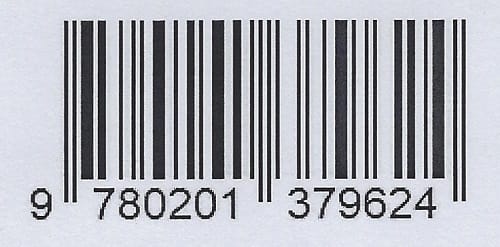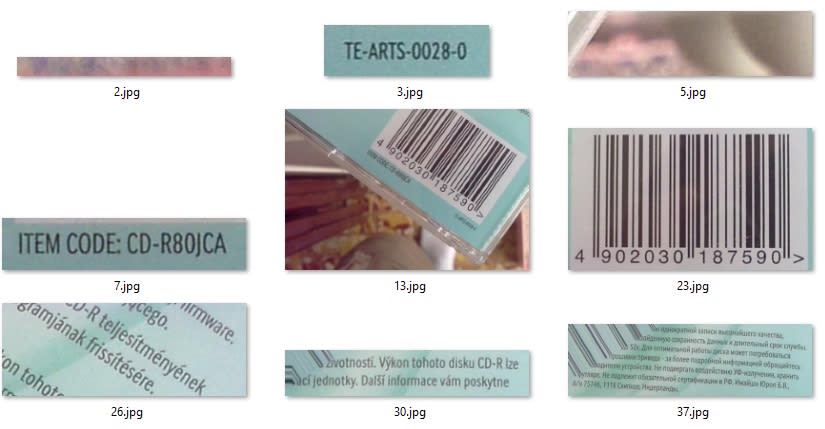18
Locating and Decoding EAN-13 Barcodes using Python and OpenCV
The International Article Number (also known as European Article Number or EAN) is a standard describing a barcode symbology and numbering system used in global trade to identify a specific retail product type. The most commonly used EAN standard is the thirteen-digit EAN-13. 1

The 13-digit EAN-13 number consists of four components:
An EAN-13 barcode has 95 areas (also known as modules) of equal width. Each area can be either white (represented here as 0) or black (represented as 1). Continuous areas form a black or white bar. There are 59 bars in an EAN-13 barcode.
From left to right, there are:
The encoding of the digit can be known by looking up the following table.
| Digit | Left-hand (Odd) | Left-hand (Even) | Right-hand |
|---|---|---|---|
| 0 | 0001101 | 0100111 | 1110010 |
| 1 | 0011001 | 0110011 | 1100110 |
| 2 | 0010011 | 0011011 | 1101100 |
| 3 | 0111101 | 0100001 | 1000010 |
| 4 | 0100011 | 0011101 | 1011100 |
| 5 | 0110001 | 0111001 | 1001110 |
| 6 | 0101111 | 0000101 | 1010000 |
| 7 | 0111011 | 0010001 | 1000100 |
| 8 | 0110111 | 0001001 | 1001000 |
| 9 | 0001011 | 0010111 | 1110100 |
The left-hand digits have a parity property which is odd and even. The initial digit can be inferred by checking the following table.
| First digit | The parity of the 6 left-hand digits |
|---|---|
| 0 | OOOOOO |
| 1 | OOEOEE |
| 2 | OOEEOE |
| 3 | OOEEEO |
| 4 | OEOOEE |
| 5 | OEEOOE |
| 6 | OEEEOO |
| 7 | OEOEOE |
| 8 | OEOEEO |
| 9 | OEEOEO |
In the following part, we will try to decode and detect EAN-13 barcodes using Python and OpenCV.
Based on the specification of EAN-13, we can create an EAN-13 barcode decoder.
Here is a test barcode images generated with an online tool:

Since it is a generated image, we can directly read the barcode data from it.
Create a thresholded image.
img = cv2.imread("generated.jpg")
gray = cv2.cvtColor(img, cv2.COLOR_BGR2GRAY)
ret, thresh =cv2.threshold(gray, 200, 255, cv2.THRESH_BINARY + cv2.THRESH_OTSU)
The value of the white pixels of the thresholded images is 255 and the black pixels 0. We need to invert it and replace 255 with 1 to conform to the 0 and 1 pattern. Only one line of the barcode is needed and here, we use the middle line.
thresh = cv2.bitwise_not(thresh)
line = thresh[int(img.shape[0]/2)]
for i in range(len(line)):
if line[i] == 255:
line[i] = 1
Read the 95 areas and detect the module size. The module size is the length of the smallest bar.
def read_bars(line):
bars = []
current_length = 1
for i in range(len(line)-1):
if line[i] == line[i+1]:
current_length = current_length + 1
else:
bars.append(current_length * str(line[i]))
current_length = 1
#remove quite zone
bars.pop(0)
return bars
def detect_module_size(bars):
size = len(bars[0])
for bar in bars:
size = min(len(bar),size)
return size
module_size = detect_module_size(read_bars(line))
Get the data string.
def array_as_string(array, module_size):
s = ""
for value in array:
s = s + str(value)
s=s.replace("1"*module_size,"1")
s=s.replace("0"*module_size,"0")
print("Data string: " + s)
return s
data_string = array_as_string(line,module_size)
The data string of the test image:
00000000000101011101100010010100111001001101001110011001010101000010100010011101001010000110110010111001010000000
Now we can separate the data string by the fixed width of digits and guard markers and decode them according to the encoding table.
Decode the left half.
def decode_left_bar_pattern(pattern):
left_pattern_dict = {}
left_pattern_dict["0001101"] = {"code":0,"parity":"O"}
left_pattern_dict["0100111"] = {"code":0,"parity":"E"}
left_pattern_dict["0011001"] = {"code":1,"parity":"O"}
left_pattern_dict["0110011"] = {"code":1,"parity":"E"}
left_pattern_dict["0010011"] = {"code":2,"parity":"O"}
left_pattern_dict["0011011"] = {"code":2,"parity":"E"}
left_pattern_dict["0111101"] = {"code":3,"parity":"O"}
left_pattern_dict["0100001"] = {"code":3,"parity":"E"}
left_pattern_dict["0100011"] = {"code":4,"parity":"O"}
left_pattern_dict["0011101"] = {"code":4,"parity":"E"}
left_pattern_dict["0110001"] = {"code":5,"parity":"O"}
left_pattern_dict["0111001"] = {"code":5,"parity":"E"}
left_pattern_dict["0101111"] = {"code":6,"parity":"O"}
left_pattern_dict["0000101"] = {"code":6,"parity":"E"}
left_pattern_dict["0111011"] = {"code":7,"parity":"O"}
left_pattern_dict["0010001"] = {"code":7,"parity":"E"}
left_pattern_dict["0110111"] = {"code":8,"parity":"O"}
left_pattern_dict["0001001"] = {"code":8,"parity":"E"}
left_pattern_dict["0001011"] = {"code":9,"parity":"O"}
left_pattern_dict["0010111"] = {"code":9,"parity":"E"}
return left_pattern_dict[pattern]
guard_pattern = "101"
center_guard_pattern = "01010"
begin_index = data_string.find(guard_pattern)+len(guard_pattern)
data_string_left = data_string[begin_index:-1]
left_codes = []
for i in range(6):
start_index = i*7
bar_pattern = data_string_left[start_index:start_index+7]
decoded = decode_left_bar_pattern(bar_pattern)
left_codes.append(decoded)
Get the initial digit.
def get_first_digit(left_codes):
parity_dict = {}
parity_dict["OOOOOO"] = 0
parity_dict["OOEOEE"] = 1
parity_dict["OOEEOE"] = 2
parity_dict["OOEEEO"] = 3
parity_dict["OEOOEE"] = 4
parity_dict["OEEOOE"] = 5
parity_dict["OEEEOO"] = 6
parity_dict["OEOEOE"] = 7
parity_dict["OEOEEO"] = 8
parity_dict["OEEOEO"] = 9
parity = ""
for code in left_codes:
parity = parity + code["parity"]
return parity_dict[parity]
Decode the right half.
def decode_right_bar_pattern(pattern):
right_pattern_dict = {}
right_pattern_dict["1110010"] = {"code":0}
right_pattern_dict["1100110"] = {"code":1}
right_pattern_dict["1101100"] = {"code":2}
right_pattern_dict["1000010"] = {"code":3}
right_pattern_dict["1011100"] = {"code":4}
right_pattern_dict["1001110"] = {"code":5}
right_pattern_dict["1010000"] = {"code":6}
right_pattern_dict["1000100"] = {"code":7}
right_pattern_dict["1001000"] = {"code":8}
right_pattern_dict["1110100"] = {"code":9}
return right_pattern_dict[pattern]
center_index = data_string_left.find(center_guard_pattern)+len(center_guard_pattern)
data_string_left = data_string_left[center_index:-1]
right_codes = []
for i in range(6):
start_index = i*7
bar_pattern = data_string_left[start_index:start_index+7]
decoded = decode_right_bar_pattern(bar_pattern)
right_codes.append(decoded)
Check if the code is valid.
We can calculate the checksum and see if it matches the final digit.
def verify(ean13):
weight = [1,3,1,3,1,3,1,3,1,3,1,3,1,3]
weighted_sum = 0
for i in range(12):
weighted_sum = weighted_sum + weight[i] * int(ean13[i])
weighted_sum = str(weighted_sum)
checksum = 0
units_digit = int(weighted_sum[-1])
if units_digit != 0:
checksum = 10 - units_digit
else:
checksum = 0
print("The checksum of "+ean13 + " is " + str(checksum))
if checksum == int(ean13[-1]):
print("The code is valid.")
return True
else:
print("The code is invalid.")
return False
The above decoding method has high requirements of image qualities. It cannot decode barcodes in the real world.
Here is a scan of a printed EAN-13 barcode and its thresholded images. We can see that the bars have many noises and the width of areas is affected by the printing.


For example, the left guard pattern should be 101 while in the scan, it is 1011, which makes it impossible to correctly detect where the barcode starts.
There are ways to improve the decoding like median blur, smooth and scanning every line. One of the ways which prove effective is using a similar edge distance algorithm to normalize the length of digit areas since they have a fixed width of 7.
You can check out this repo to learn more.
Let's take a step further to detect barcodes in an image.
A basic detection method based on morphology and contours finding is used in this article.
Here is a sample image from the Artelab Medium Barcode 1D Collection:

We can see that the barcode has parallel lines, white background and quiet zones, making it very different from the rest of the content.
Let's try to detect the barcode.
Resize the image for normalization.
img = cv2.imread("05102009081.jpg")
scale_percent = 640/img.shape[1]
width = int(img.shape[1] * scale_percent)
height = int(img.shape[0] * scale_percent)
dim = (width, height)
resized = cv2.resize(img, dim, interpolation = cv2.INTER_AREA)
Create a thresholded image.
gray = cv2.cvtColor(resized, cv2.COLOR_BGR2GRAY)
ret, thresh =cv2.threshold(gray, 200, 255, cv2.THRESH_BINARY + cv2.THRESH_OTSU)
Invert and dilate.
thresh = cv2.bitwise_not(thresh)
kernel = np.ones((3, 20), np.uint8)
thresh = cv2.dilate(thresh, kernel)
Find contours and get the cropped and rotated candidate areas.
def crop_rect(rect, box, img):
W = rect[1][0]
H = rect[1][1]
Xs = [i[0] for i in box]
Ys = [i[1] for i in box]
x1 = min(Xs)
x2 = max(Xs)
y1 = min(Ys)
y2 = max(Ys)
# Center of rectangle in source image
center = ((x1+x2)/2,(y1+y2)/2)
# Size of the upright rectangle bounding the rotated rectangle
size = (x2-x1, y2-y1)
# Cropped upright rectangle
cropped = cv2.getRectSubPix(img, size, center)
angle = rect[2]
if angle!=90: #need rotation
if angle>45:
angle = 0 - (90 - angle)
else:
angle = angle
M = cv2.getRotationMatrix2D((size[0]/2, size[1]/2), angle, 1.0)
cropped = cv2.warpAffine(cropped, M, size)
croppedW = H if H > W else W
croppedH = H if H < W else W
# Final cropped & rotated rectangle
croppedRotated = cv2.getRectSubPix(cropped, (int(croppedW),int(croppedH)), (size[0]/2, size[1]/2))
return croppedRotated
return cropped
original_sized = cv2.resize(thresh, (img.shape[1],img.shape[0]), interpolation = cv2.INTER_AREA)
contours, hierarchy = cv2.findContours(original_sized,cv2.RETR_TREE,cv2.CHAIN_APPROX_SIMPLE)
candidates = []
index = 0
added_index = []
for cnt in contours:
rect = cv2.minAreaRect(cnt)
box = cv2.boxPoints(rect)
box = np.int0(box)
cropped = crop_rect(rect,box,img)
width = cropped.shape[1]
child_index = hierarchy[0][index][2]
#the min width of EAN13 is 95 pixel
if width>95:
has_overlapped = False
if child_index in added_index:
has_overlapped = True
if has_overlapped == False:
added_index.append(index)
candidate = {"cropped": cropped, "rect": rect}
candidates.append(candidate)
index = index + 1
We can get the following candidates. We can later send them to decode.
Now, we can create an EAN-13 reader combining the detecting and decoding parts.
import decode as decoder
import detect as detector
import cv2
import numpy as np
def decode_image(image):
result_dict = {}
results = []
candidates = detector.detect(image)
for i in range(len(candidates)):
candidate = candidates[i]
cropped = candidate["cropped"]
rect = candidate["rect"]
box = cv2.boxPoints(rect)
box = np.int0(box)
ean13, is_valid, thresh = decoder.decode(cropped)
if is_valid:
result = {}
result["barcodeFormat"] = "EAN13"
result["barcodeText"] = ean13
result["x1"] = int(box[0][0])
result["y1"] = int(box[0][1])
result["x2"] = int(box[1][0])
result["y2"] = int(box[1][1])
result["x3"] = int(box[2][0])
result["y3"] = int(box[2][1])
result["x4"] = int(box[3][0])
result["y4"] = int(box[3][1])
results.append(result)
result_dict["results"] = results
return result_dict
if __name__ == "__main__":
image = cv2.imread("multiple.jpg")
result_dict = decode_image(image)
results = result_dict["results"]
text = "No barcode found"
if len(results) > 0:
for result in results:
if text == "No barcode found":
text = "Code: "
ean13 = result["barcodeText"]
text = text + ean13 + " "
cv2.line(image,(result["x1"],result["y1"]),(result["x2"],result["y2"]),(0,255,0),3)
cv2.line(image,(result["x2"],result["y2"]),(result["x3"],result["y3"]),(0,255,0),3)
cv2.line(image,(result["x3"],result["y3"]),(result["x4"],result["y4"]),(0,255,0),3)
cv2.line(image,(result["x4"],result["y4"]),(result["x1"],result["y1"]),(0,255,0),3)
scale_percent = 640/image.shape[1]
width = int(image.shape[1] * scale_percent)
height = int(image.shape[0] * scale_percent)
dim = (width, height)
resized = cv2.resize(image, dim, interpolation = cv2.INTER_AREA)
cv2.putText(resized, text, (5,50), cv2.FONT_HERSHEY_SIMPLEX, 0.75, (0, 0, 255), 2)
cv2.imshow("result", resized);
cv2.waitKey(0);
cv2.destroyAllWindows();
18



